Comprehensive Report: Partnership Working in Health and Social Care
VerifiedAdded on 2020/01/15
|13
|3995
|165
Report
AI Summary
This report delves into the critical aspects of partnership working within the health and social care sectors. It begins by outlining the core philosophies underpinning such collaborations, emphasizing the importance of independence, power-sharing, respect, and empowerment. The report then examines the various partnership relationships, highlighting the factors driving the need for collaborative efforts, such as the increasing number of vulnerable and aging populations and the need for cost-effective care. It further explores the models of partnership working, differentiating between practical and theoretical models, including unified, coordinated, coalition, and hybrid approaches. The report also reviews relevant legislation, such as the Data Protection Act and the Equality Act, and organizational practices impacting partnership effectiveness. It concludes by analyzing potential barriers to partnership working, such as cultural and communication differences, and proposes strategies to enhance outcomes for service users, professionals, and organizations within the health and social care landscape.

Working people
Paraphrase This Document
Need a fresh take? Get an instant paraphrase of this document with our AI Paraphraser
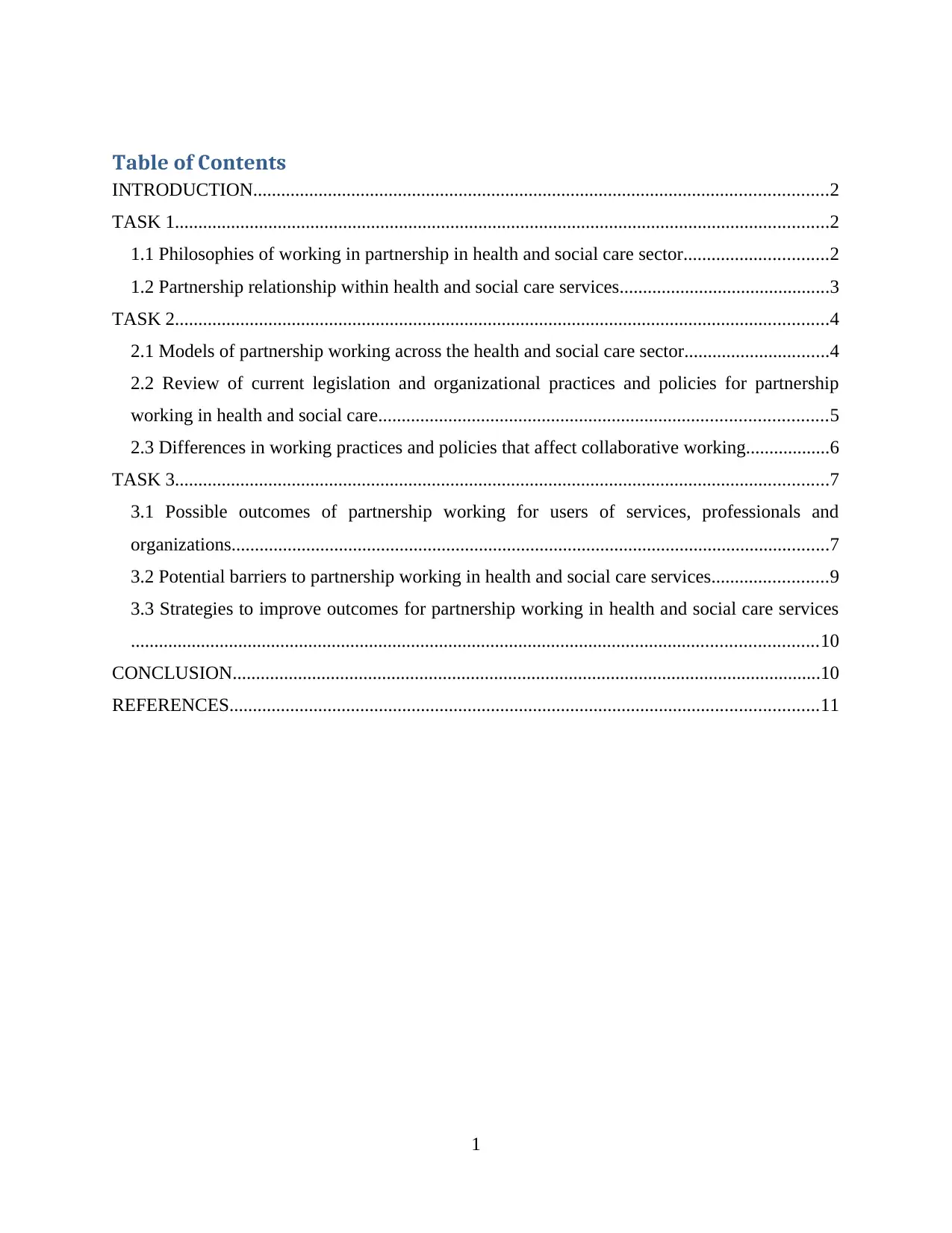
Table of Contents
INTRODUCTION...........................................................................................................................2
TASK 1............................................................................................................................................2
1.1 Philosophies of working in partnership in health and social care sector...............................2
1.2 Partnership relationship within health and social care services.............................................3
TASK 2............................................................................................................................................4
2.1 Models of partnership working across the health and social care sector...............................4
2.2 Review of current legislation and organizational practices and policies for partnership
working in health and social care................................................................................................5
2.3 Differences in working practices and policies that affect collaborative working..................6
TASK 3............................................................................................................................................7
3.1 Possible outcomes of partnership working for users of services, professionals and
organizations................................................................................................................................7
3.2 Potential barriers to partnership working in health and social care services.........................9
3.3 Strategies to improve outcomes for partnership working in health and social care services
...................................................................................................................................................10
CONCLUSION..............................................................................................................................10
REFERENCES..............................................................................................................................11
1
INTRODUCTION...........................................................................................................................2
TASK 1............................................................................................................................................2
1.1 Philosophies of working in partnership in health and social care sector...............................2
1.2 Partnership relationship within health and social care services.............................................3
TASK 2............................................................................................................................................4
2.1 Models of partnership working across the health and social care sector...............................4
2.2 Review of current legislation and organizational practices and policies for partnership
working in health and social care................................................................................................5
2.3 Differences in working practices and policies that affect collaborative working..................6
TASK 3............................................................................................................................................7
3.1 Possible outcomes of partnership working for users of services, professionals and
organizations................................................................................................................................7
3.2 Potential barriers to partnership working in health and social care services.........................9
3.3 Strategies to improve outcomes for partnership working in health and social care services
...................................................................................................................................................10
CONCLUSION..............................................................................................................................10
REFERENCES..............................................................................................................................11
1

INTRODUCTION
Working with many people in partnership is about developing mutual beneficial
relationship between individual partners for long term condition. In health and social care sector,
the main motive of partnership working is to improve the quality of services and care experience
of patients in an effective manner (Claire and et.al., 2011). In partnership working, two or more
entities work together for a common objective by equally pooling required resources in business.
In this context, required resources are capital, man power and skills (Clarke, 2016). This report
includes the concept about philosophies of working in partnership and relationships in health and
social care services. Further, it helps to understand that how to promote positive partnership
working with users of professionals, services and health care organizations in this sector. The
present report also helps to describe the possible outcomes and potential barriers of partnership
working in this sector.
TASK 1
1.1 Philosophies of working in partnership in health and social care sector
Philosophies of working in partnership are related to both beliefs as well as values and
these are associated with collaboration working between health care organizations and agencies.
The main motive of working in partnership is to offer support and quality based care services to
patients (Cook, 2006). There are few types of philosophies present in health and social care
sector that strengthen the partnership worming procedure. Philosophies of working in partnership
are defined below as:
Philosophy of independence
This philosophy refers to the ability to make decisions about the important aspects of
person's life without control of family members. It is associated with the personal traits like
control and ability etc. It describes that individual is not under the power and control of others.
According to this, anatomy is given to service user so, they could choose the way and method of
treatment (Cowan, 2009).
Philosophy of power sharing
This philosophy defines power sharing as a process of negotiation which aims is to
achieve understandings related to ownership, responsibilities and roles. In this health care sector,
professionals share few responsibilities with each other to provide effective care services to their
2
Working with many people in partnership is about developing mutual beneficial
relationship between individual partners for long term condition. In health and social care sector,
the main motive of partnership working is to improve the quality of services and care experience
of patients in an effective manner (Claire and et.al., 2011). In partnership working, two or more
entities work together for a common objective by equally pooling required resources in business.
In this context, required resources are capital, man power and skills (Clarke, 2016). This report
includes the concept about philosophies of working in partnership and relationships in health and
social care services. Further, it helps to understand that how to promote positive partnership
working with users of professionals, services and health care organizations in this sector. The
present report also helps to describe the possible outcomes and potential barriers of partnership
working in this sector.
TASK 1
1.1 Philosophies of working in partnership in health and social care sector
Philosophies of working in partnership are related to both beliefs as well as values and
these are associated with collaboration working between health care organizations and agencies.
The main motive of working in partnership is to offer support and quality based care services to
patients (Cook, 2006). There are few types of philosophies present in health and social care
sector that strengthen the partnership worming procedure. Philosophies of working in partnership
are defined below as:
Philosophy of independence
This philosophy refers to the ability to make decisions about the important aspects of
person's life without control of family members. It is associated with the personal traits like
control and ability etc. It describes that individual is not under the power and control of others.
According to this, anatomy is given to service user so, they could choose the way and method of
treatment (Cowan, 2009).
Philosophy of power sharing
This philosophy defines power sharing as a process of negotiation which aims is to
achieve understandings related to ownership, responsibilities and roles. In this health care sector,
professionals share few responsibilities with each other to provide effective care services to their
2
⊘ This is a preview!⊘
Do you want full access?
Subscribe today to unlock all pages.

Trusted by 1+ million students worldwide
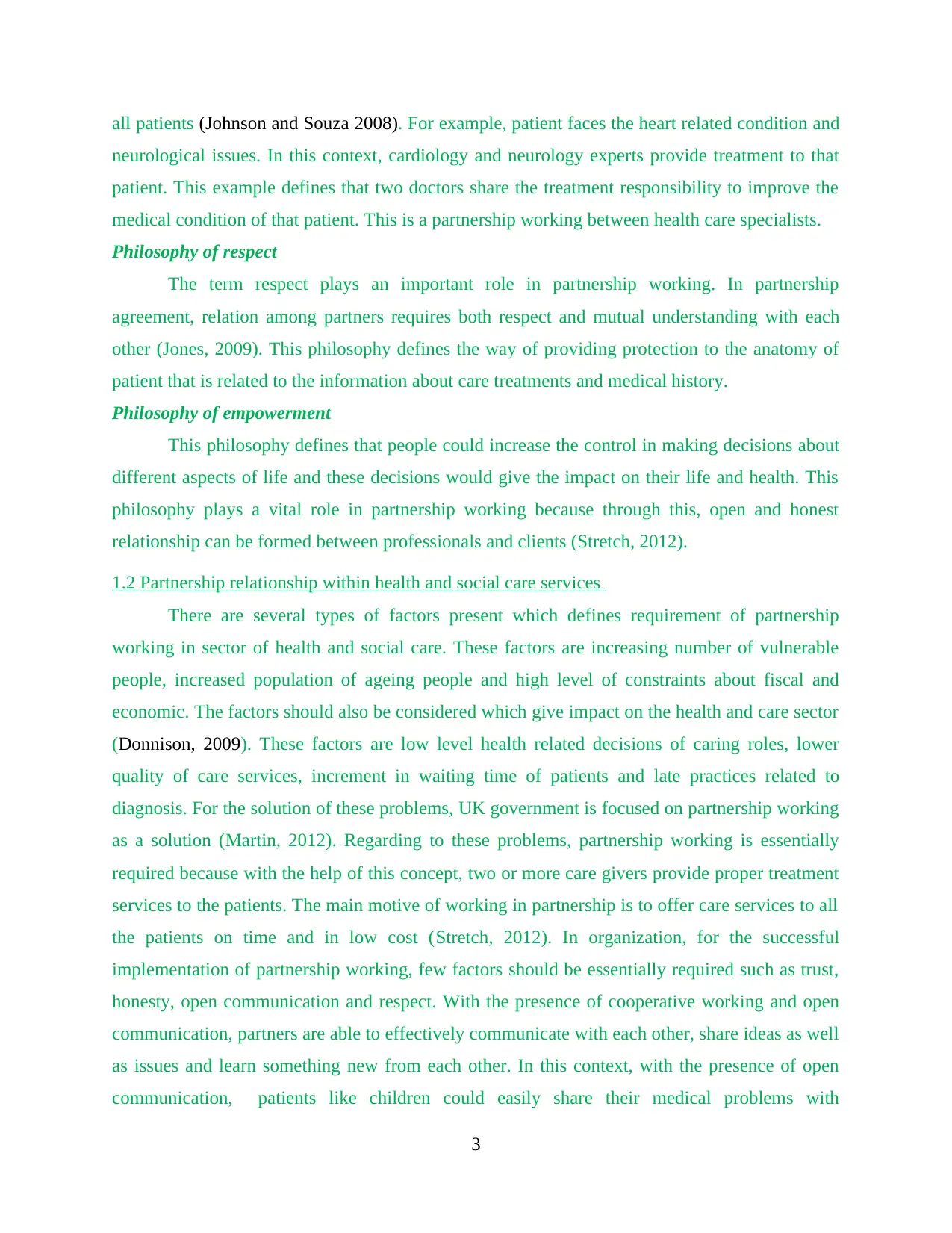
all patients (Johnson and Souza 2008). For example, patient faces the heart related condition and
neurological issues. In this context, cardiology and neurology experts provide treatment to that
patient. This example defines that two doctors share the treatment responsibility to improve the
medical condition of that patient. This is a partnership working between health care specialists.
Philosophy of respect
The term respect plays an important role in partnership working. In partnership
agreement, relation among partners requires both respect and mutual understanding with each
other (Jones, 2009). This philosophy defines the way of providing protection to the anatomy of
patient that is related to the information about care treatments and medical history.
Philosophy of empowerment
This philosophy defines that people could increase the control in making decisions about
different aspects of life and these decisions would give the impact on their life and health. This
philosophy plays a vital role in partnership working because through this, open and honest
relationship can be formed between professionals and clients (Stretch, 2012).
1.2 Partnership relationship within health and social care services
There are several types of factors present which defines requirement of partnership
working in sector of health and social care. These factors are increasing number of vulnerable
people, increased population of ageing people and high level of constraints about fiscal and
economic. The factors should also be considered which give impact on the health and care sector
(Donnison, 2009). These factors are low level health related decisions of caring roles, lower
quality of care services, increment in waiting time of patients and late practices related to
diagnosis. For the solution of these problems, UK government is focused on partnership working
as a solution (Martin, 2012). Regarding to these problems, partnership working is essentially
required because with the help of this concept, two or more care givers provide proper treatment
services to the patients. The main motive of working in partnership is to offer care services to all
the patients on time and in low cost (Stretch, 2012). In organization, for the successful
implementation of partnership working, few factors should be essentially required such as trust,
honesty, open communication and respect. With the presence of cooperative working and open
communication, partners are able to effectively communicate with each other, share ideas as well
as issues and learn something new from each other. In this context, with the presence of open
communication, patients like children could easily share their medical problems with
3
neurological issues. In this context, cardiology and neurology experts provide treatment to that
patient. This example defines that two doctors share the treatment responsibility to improve the
medical condition of that patient. This is a partnership working between health care specialists.
Philosophy of respect
The term respect plays an important role in partnership working. In partnership
agreement, relation among partners requires both respect and mutual understanding with each
other (Jones, 2009). This philosophy defines the way of providing protection to the anatomy of
patient that is related to the information about care treatments and medical history.
Philosophy of empowerment
This philosophy defines that people could increase the control in making decisions about
different aspects of life and these decisions would give the impact on their life and health. This
philosophy plays a vital role in partnership working because through this, open and honest
relationship can be formed between professionals and clients (Stretch, 2012).
1.2 Partnership relationship within health and social care services
There are several types of factors present which defines requirement of partnership
working in sector of health and social care. These factors are increasing number of vulnerable
people, increased population of ageing people and high level of constraints about fiscal and
economic. The factors should also be considered which give impact on the health and care sector
(Donnison, 2009). These factors are low level health related decisions of caring roles, lower
quality of care services, increment in waiting time of patients and late practices related to
diagnosis. For the solution of these problems, UK government is focused on partnership working
as a solution (Martin, 2012). Regarding to these problems, partnership working is essentially
required because with the help of this concept, two or more care givers provide proper treatment
services to the patients. The main motive of working in partnership is to offer care services to all
the patients on time and in low cost (Stretch, 2012). In organization, for the successful
implementation of partnership working, few factors should be essentially required such as trust,
honesty, open communication and respect. With the presence of cooperative working and open
communication, partners are able to effectively communicate with each other, share ideas as well
as issues and learn something new from each other. In this context, with the presence of open
communication, patients like children could easily share their medical problems with
3
Paraphrase This Document
Need a fresh take? Get an instant paraphrase of this document with our AI Paraphraser
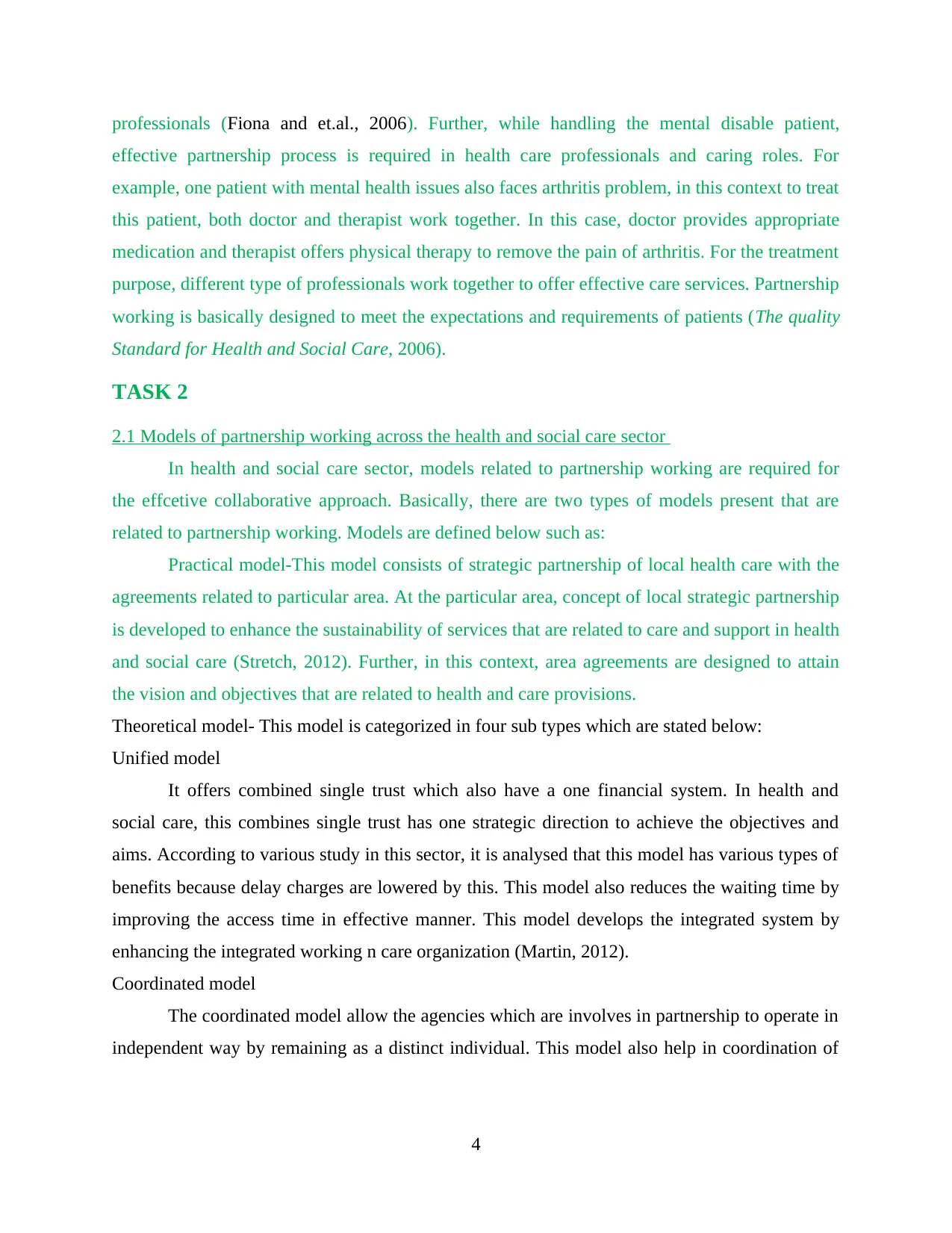
professionals (Fiona and et.al., 2006). Further, while handling the mental disable patient,
effective partnership process is required in health care professionals and caring roles. For
example, one patient with mental health issues also faces arthritis problem, in this context to treat
this patient, both doctor and therapist work together. In this case, doctor provides appropriate
medication and therapist offers physical therapy to remove the pain of arthritis. For the treatment
purpose, different type of professionals work together to offer effective care services. Partnership
working is basically designed to meet the expectations and requirements of patients (The quality
Standard for Health and Social Care, 2006).
TASK 2
2.1 Models of partnership working across the health and social care sector
In health and social care sector, models related to partnership working are required for
the effcetive collaborative approach. Basically, there are two types of models present that are
related to partnership working. Models are defined below such as:
Practical model-This model consists of strategic partnership of local health care with the
agreements related to particular area. At the particular area, concept of local strategic partnership
is developed to enhance the sustainability of services that are related to care and support in health
and social care (Stretch, 2012). Further, in this context, area agreements are designed to attain
the vision and objectives that are related to health and care provisions.
Theoretical model- This model is categorized in four sub types which are stated below:
Unified model
It offers combined single trust which also have a one financial system. In health and
social care, this combines single trust has one strategic direction to achieve the objectives and
aims. According to various study in this sector, it is analysed that this model has various types of
benefits because delay charges are lowered by this. This model also reduces the waiting time by
improving the access time in effective manner. This model develops the integrated system by
enhancing the integrated working n care organization (Martin, 2012).
Coordinated model
The coordinated model allow the agencies which are involves in partnership to operate in
independent way by remaining as a distinct individual. This model also help in coordination of
4
effective partnership process is required in health care professionals and caring roles. For
example, one patient with mental health issues also faces arthritis problem, in this context to treat
this patient, both doctor and therapist work together. In this case, doctor provides appropriate
medication and therapist offers physical therapy to remove the pain of arthritis. For the treatment
purpose, different type of professionals work together to offer effective care services. Partnership
working is basically designed to meet the expectations and requirements of patients (The quality
Standard for Health and Social Care, 2006).
TASK 2
2.1 Models of partnership working across the health and social care sector
In health and social care sector, models related to partnership working are required for
the effcetive collaborative approach. Basically, there are two types of models present that are
related to partnership working. Models are defined below such as:
Practical model-This model consists of strategic partnership of local health care with the
agreements related to particular area. At the particular area, concept of local strategic partnership
is developed to enhance the sustainability of services that are related to care and support in health
and social care (Stretch, 2012). Further, in this context, area agreements are designed to attain
the vision and objectives that are related to health and care provisions.
Theoretical model- This model is categorized in four sub types which are stated below:
Unified model
It offers combined single trust which also have a one financial system. In health and
social care, this combines single trust has one strategic direction to achieve the objectives and
aims. According to various study in this sector, it is analysed that this model has various types of
benefits because delay charges are lowered by this. This model also reduces the waiting time by
improving the access time in effective manner. This model develops the integrated system by
enhancing the integrated working n care organization (Martin, 2012).
Coordinated model
The coordinated model allow the agencies which are involves in partnership to operate in
independent way by remaining as a distinct individual. This model also help in coordination of
4
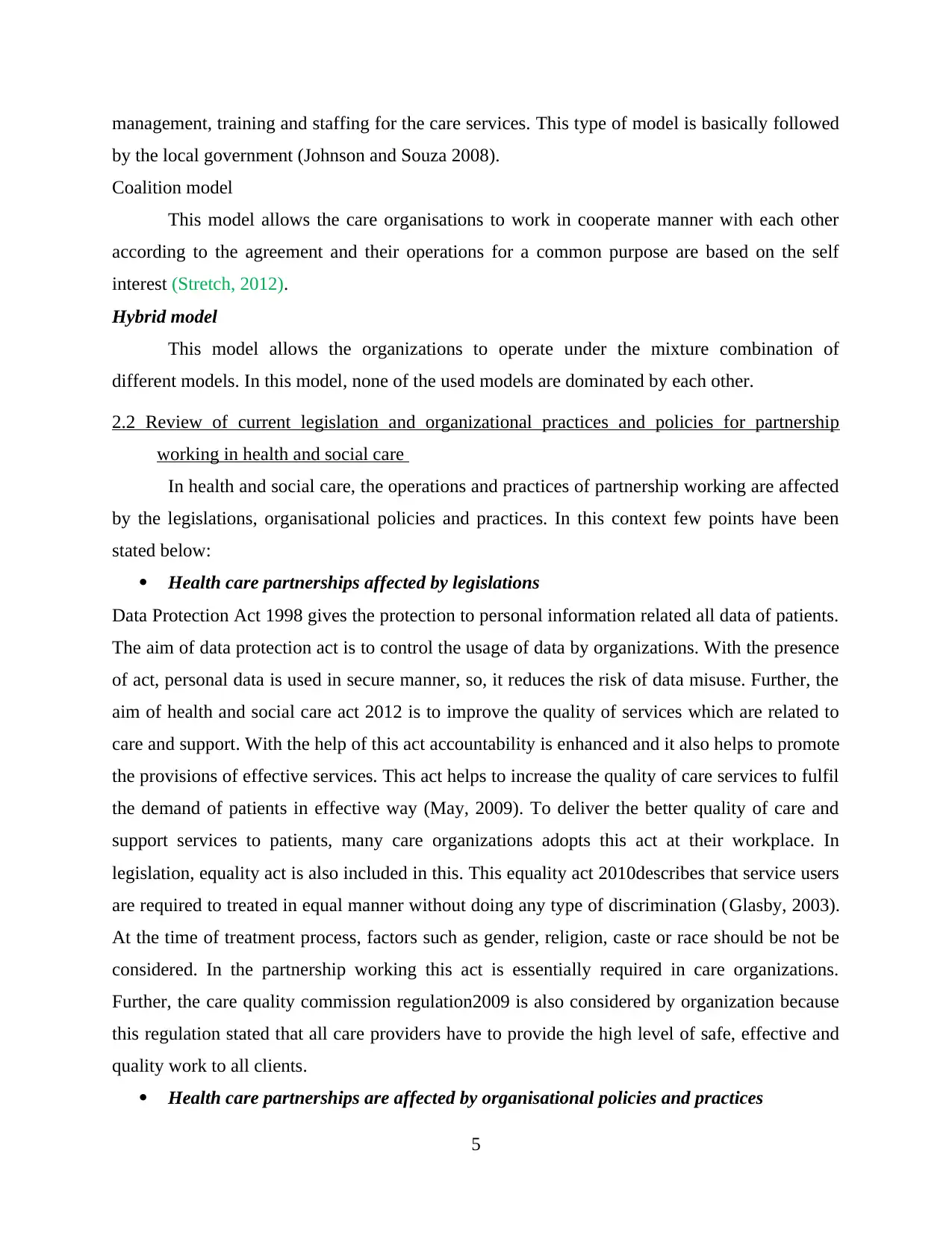
management, training and staffing for the care services. This type of model is basically followed
by the local government (Johnson and Souza 2008).
Coalition model
This model allows the care organisations to work in cooperate manner with each other
according to the agreement and their operations for a common purpose are based on the self
interest (Stretch, 2012).
Hybrid model
This model allows the organizations to operate under the mixture combination of
different models. In this model, none of the used models are dominated by each other.
2.2 Review of current legislation and organizational practices and policies for partnership
working in health and social care
In health and social care, the operations and practices of partnership working are affected
by the legislations, organisational policies and practices. In this context few points have been
stated below:
Health care partnerships affected by legislations
Data Protection Act 1998 gives the protection to personal information related all data of patients.
The aim of data protection act is to control the usage of data by organizations. With the presence
of act, personal data is used in secure manner, so, it reduces the risk of data misuse. Further, the
aim of health and social care act 2012 is to improve the quality of services which are related to
care and support. With the help of this act accountability is enhanced and it also helps to promote
the provisions of effective services. This act helps to increase the quality of care services to fulfil
the demand of patients in effective way (May, 2009). To deliver the better quality of care and
support services to patients, many care organizations adopts this act at their workplace. In
legislation, equality act is also included in this. This equality act 2010describes that service users
are required to treated in equal manner without doing any type of discrimination (Glasby, 2003).
At the time of treatment process, factors such as gender, religion, caste or race should be not be
considered. In the partnership working this act is essentially required in care organizations.
Further, the care quality commission regulation2009 is also considered by organization because
this regulation stated that all care providers have to provide the high level of safe, effective and
quality work to all clients.
Health care partnerships are affected by organisational policies and practices
5
by the local government (Johnson and Souza 2008).
Coalition model
This model allows the care organisations to work in cooperate manner with each other
according to the agreement and their operations for a common purpose are based on the self
interest (Stretch, 2012).
Hybrid model
This model allows the organizations to operate under the mixture combination of
different models. In this model, none of the used models are dominated by each other.
2.2 Review of current legislation and organizational practices and policies for partnership
working in health and social care
In health and social care, the operations and practices of partnership working are affected
by the legislations, organisational policies and practices. In this context few points have been
stated below:
Health care partnerships affected by legislations
Data Protection Act 1998 gives the protection to personal information related all data of patients.
The aim of data protection act is to control the usage of data by organizations. With the presence
of act, personal data is used in secure manner, so, it reduces the risk of data misuse. Further, the
aim of health and social care act 2012 is to improve the quality of services which are related to
care and support. With the help of this act accountability is enhanced and it also helps to promote
the provisions of effective services. This act helps to increase the quality of care services to fulfil
the demand of patients in effective way (May, 2009). To deliver the better quality of care and
support services to patients, many care organizations adopts this act at their workplace. In
legislation, equality act is also included in this. This equality act 2010describes that service users
are required to treated in equal manner without doing any type of discrimination (Glasby, 2003).
At the time of treatment process, factors such as gender, religion, caste or race should be not be
considered. In the partnership working this act is essentially required in care organizations.
Further, the care quality commission regulation2009 is also considered by organization because
this regulation stated that all care providers have to provide the high level of safe, effective and
quality work to all clients.
Health care partnerships are affected by organisational policies and practices
5
⊘ This is a preview!⊘
Do you want full access?
Subscribe today to unlock all pages.

Trusted by 1+ million students worldwide
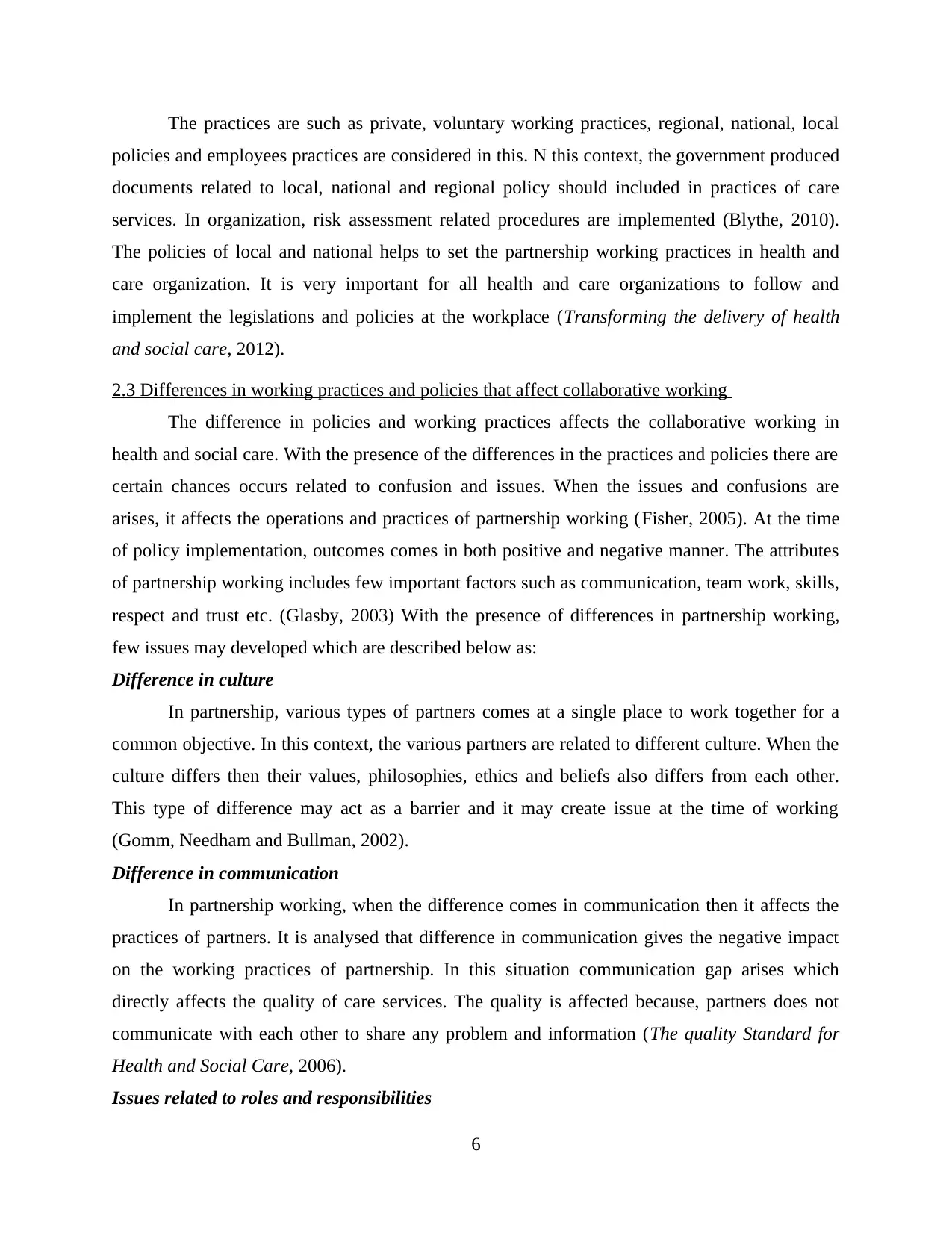
The practices are such as private, voluntary working practices, regional, national, local
policies and employees practices are considered in this. N this context, the government produced
documents related to local, national and regional policy should included in practices of care
services. In organization, risk assessment related procedures are implemented (Blythe, 2010).
The policies of local and national helps to set the partnership working practices in health and
care organization. It is very important for all health and care organizations to follow and
implement the legislations and policies at the workplace (Transforming the delivery of health
and social care, 2012).
2.3 Differences in working practices and policies that affect collaborative working
The difference in policies and working practices affects the collaborative working in
health and social care. With the presence of the differences in the practices and policies there are
certain chances occurs related to confusion and issues. When the issues and confusions are
arises, it affects the operations and practices of partnership working (Fisher, 2005). At the time
of policy implementation, outcomes comes in both positive and negative manner. The attributes
of partnership working includes few important factors such as communication, team work, skills,
respect and trust etc. (Glasby, 2003) With the presence of differences in partnership working,
few issues may developed which are described below as:
Difference in culture
In partnership, various types of partners comes at a single place to work together for a
common objective. In this context, the various partners are related to different culture. When the
culture differs then their values, philosophies, ethics and beliefs also differs from each other.
This type of difference may act as a barrier and it may create issue at the time of working
(Gomm, Needham and Bullman, 2002).
Difference in communication
In partnership working, when the difference comes in communication then it affects the
practices of partners. It is analysed that difference in communication gives the negative impact
on the working practices of partnership. In this situation communication gap arises which
directly affects the quality of care services. The quality is affected because, partners does not
communicate with each other to share any problem and information (The quality Standard for
Health and Social Care, 2006).
Issues related to roles and responsibilities
6
policies and employees practices are considered in this. N this context, the government produced
documents related to local, national and regional policy should included in practices of care
services. In organization, risk assessment related procedures are implemented (Blythe, 2010).
The policies of local and national helps to set the partnership working practices in health and
care organization. It is very important for all health and care organizations to follow and
implement the legislations and policies at the workplace (Transforming the delivery of health
and social care, 2012).
2.3 Differences in working practices and policies that affect collaborative working
The difference in policies and working practices affects the collaborative working in
health and social care. With the presence of the differences in the practices and policies there are
certain chances occurs related to confusion and issues. When the issues and confusions are
arises, it affects the operations and practices of partnership working (Fisher, 2005). At the time
of policy implementation, outcomes comes in both positive and negative manner. The attributes
of partnership working includes few important factors such as communication, team work, skills,
respect and trust etc. (Glasby, 2003) With the presence of differences in partnership working,
few issues may developed which are described below as:
Difference in culture
In partnership, various types of partners comes at a single place to work together for a
common objective. In this context, the various partners are related to different culture. When the
culture differs then their values, philosophies, ethics and beliefs also differs from each other.
This type of difference may act as a barrier and it may create issue at the time of working
(Gomm, Needham and Bullman, 2002).
Difference in communication
In partnership working, when the difference comes in communication then it affects the
practices of partners. It is analysed that difference in communication gives the negative impact
on the working practices of partnership. In this situation communication gap arises which
directly affects the quality of care services. The quality is affected because, partners does not
communicate with each other to share any problem and information (The quality Standard for
Health and Social Care, 2006).
Issues related to roles and responsibilities
6
Paraphrase This Document
Need a fresh take? Get an instant paraphrase of this document with our AI Paraphraser
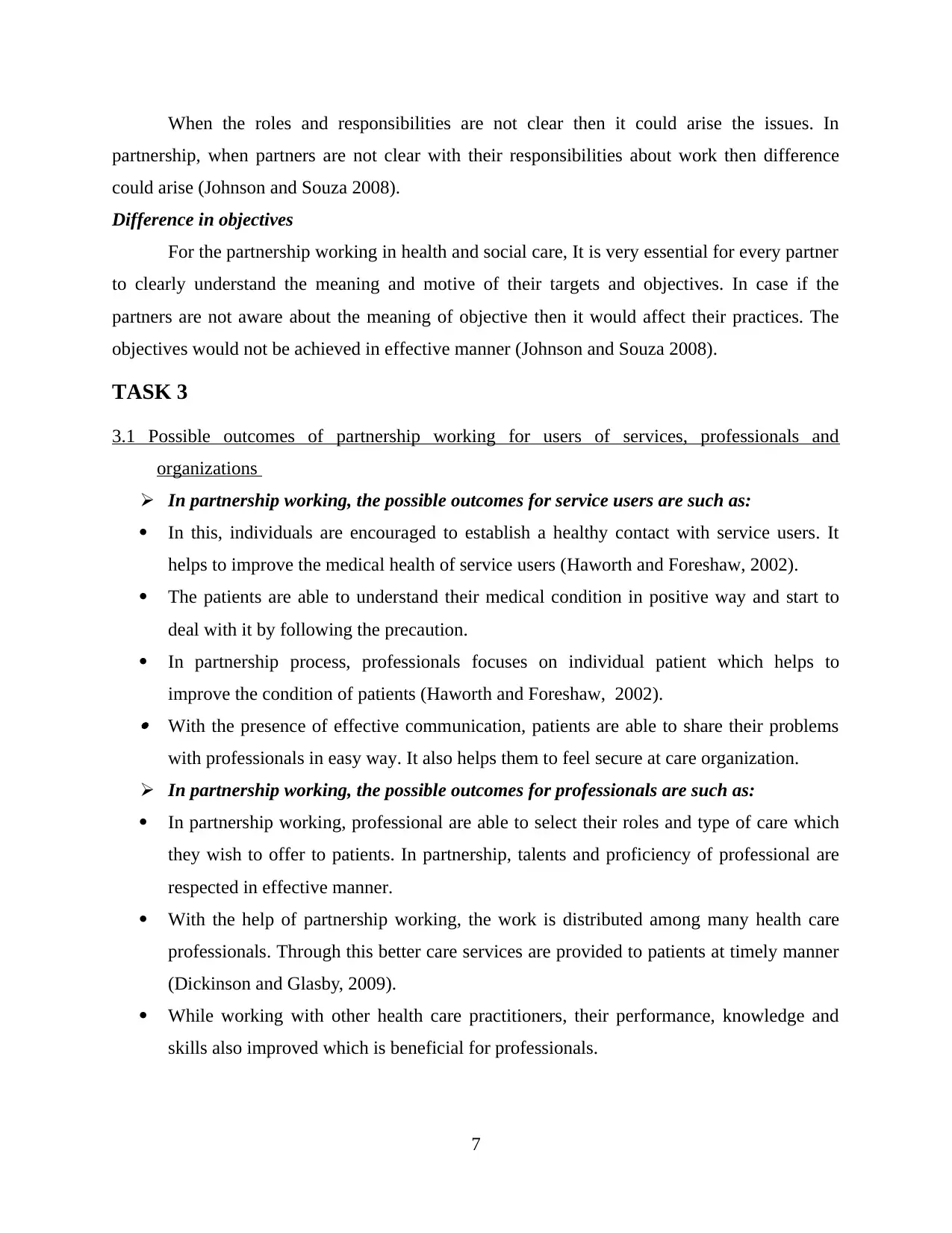
When the roles and responsibilities are not clear then it could arise the issues. In
partnership, when partners are not clear with their responsibilities about work then difference
could arise (Johnson and Souza 2008).
Difference in objectives
For the partnership working in health and social care, It is very essential for every partner
to clearly understand the meaning and motive of their targets and objectives. In case if the
partners are not aware about the meaning of objective then it would affect their practices. The
objectives would not be achieved in effective manner (Johnson and Souza 2008).
TASK 3
3.1 Possible outcomes of partnership working for users of services, professionals and
organizations
In partnership working, the possible outcomes for service users are such as:
In this, individuals are encouraged to establish a healthy contact with service users. It
helps to improve the medical health of service users (Haworth and Foreshaw, 2002).
The patients are able to understand their medical condition in positive way and start to
deal with it by following the precaution.
In partnership process, professionals focuses on individual patient which helps to
improve the condition of patients (Haworth and Foreshaw, 2002). With the presence of effective communication, patients are able to share their problems
with professionals in easy way. It also helps them to feel secure at care organization.
In partnership working, the possible outcomes for professionals are such as:
In partnership working, professional are able to select their roles and type of care which
they wish to offer to patients. In partnership, talents and proficiency of professional are
respected in effective manner.
With the help of partnership working, the work is distributed among many health care
professionals. Through this better care services are provided to patients at timely manner
(Dickinson and Glasby, 2009).
While working with other health care practitioners, their performance, knowledge and
skills also improved which is beneficial for professionals.
7
partnership, when partners are not clear with their responsibilities about work then difference
could arise (Johnson and Souza 2008).
Difference in objectives
For the partnership working in health and social care, It is very essential for every partner
to clearly understand the meaning and motive of their targets and objectives. In case if the
partners are not aware about the meaning of objective then it would affect their practices. The
objectives would not be achieved in effective manner (Johnson and Souza 2008).
TASK 3
3.1 Possible outcomes of partnership working for users of services, professionals and
organizations
In partnership working, the possible outcomes for service users are such as:
In this, individuals are encouraged to establish a healthy contact with service users. It
helps to improve the medical health of service users (Haworth and Foreshaw, 2002).
The patients are able to understand their medical condition in positive way and start to
deal with it by following the precaution.
In partnership process, professionals focuses on individual patient which helps to
improve the condition of patients (Haworth and Foreshaw, 2002). With the presence of effective communication, patients are able to share their problems
with professionals in easy way. It also helps them to feel secure at care organization.
In partnership working, the possible outcomes for professionals are such as:
In partnership working, professional are able to select their roles and type of care which
they wish to offer to patients. In partnership, talents and proficiency of professional are
respected in effective manner.
With the help of partnership working, the work is distributed among many health care
professionals. Through this better care services are provided to patients at timely manner
(Dickinson and Glasby, 2009).
While working with other health care practitioners, their performance, knowledge and
skills also improved which is beneficial for professionals.
7

Professionals are easily available to patients because their work is distributed with other
practitioners (Haworth and Foreshaw,2002).
In partnership working, the possible outcomes for care organizations are such as:
With the presence of partnership working in organization, the quality of care services also
increase. This creates a positive image in front of all service users (May, 2009).
All partners tries to fulfil the needs and requirements of service users in effective.
Through this, patients would like to prefer same care organization In the future.
Various health care related centres for different diseases are established in organization
(Glasby, 2003).
With the positive image the public and other agencies would like to give fund which
would used in care services.
3.2 Potential barriers to partnership working in health and social care services
In health and social care sector, the potential barriers to partnership working affects its
operations, development and growth. The potential barriers to partnership working are described
below such as:
Absence of trust- With the poor quality of care services, the patients looses their trust towards
caring roles and care organization. For the solution of this problem care organization to
implement few strategies to regain the trust of patients (Team working and effectiveness in health
care. 2014).
Different priorities- If the priorities of partners are changed then it also acts as barrier in
practices of partnership working. In initial stage, all partners share the same objective to serve
the effective caring services to patients but when in tea if the objective of one partner changes
then it gives adverse impact on the whole team and their work (Stretch, 2012).
Lack of required skills and knowledge- If the required skills and knowledge are not present in
health care professionals then they are not able to understand the medical requirements of
patients. With the improper diagnose, the effective care services could be provided by all caring
roles (Claire and et.al., 2011). This would give the negative impact on the health of patient. The
lack of skills in caring roles creates a negative image of care organization in front of public and
patients.
Communication lack-Without effective communication between partners of partnership working
affects the quality of care services. In this context, lack of communication leads to lack of
8
practitioners (Haworth and Foreshaw,2002).
In partnership working, the possible outcomes for care organizations are such as:
With the presence of partnership working in organization, the quality of care services also
increase. This creates a positive image in front of all service users (May, 2009).
All partners tries to fulfil the needs and requirements of service users in effective.
Through this, patients would like to prefer same care organization In the future.
Various health care related centres for different diseases are established in organization
(Glasby, 2003).
With the positive image the public and other agencies would like to give fund which
would used in care services.
3.2 Potential barriers to partnership working in health and social care services
In health and social care sector, the potential barriers to partnership working affects its
operations, development and growth. The potential barriers to partnership working are described
below such as:
Absence of trust- With the poor quality of care services, the patients looses their trust towards
caring roles and care organization. For the solution of this problem care organization to
implement few strategies to regain the trust of patients (Team working and effectiveness in health
care. 2014).
Different priorities- If the priorities of partners are changed then it also acts as barrier in
practices of partnership working. In initial stage, all partners share the same objective to serve
the effective caring services to patients but when in tea if the objective of one partner changes
then it gives adverse impact on the whole team and their work (Stretch, 2012).
Lack of required skills and knowledge- If the required skills and knowledge are not present in
health care professionals then they are not able to understand the medical requirements of
patients. With the improper diagnose, the effective care services could be provided by all caring
roles (Claire and et.al., 2011). This would give the negative impact on the health of patient. The
lack of skills in caring roles creates a negative image of care organization in front of public and
patients.
Communication lack-Without effective communication between partners of partnership working
affects the quality of care services. In this context, lack of communication leads to lack of
8
⊘ This is a preview!⊘
Do you want full access?
Subscribe today to unlock all pages.

Trusted by 1+ million students worldwide
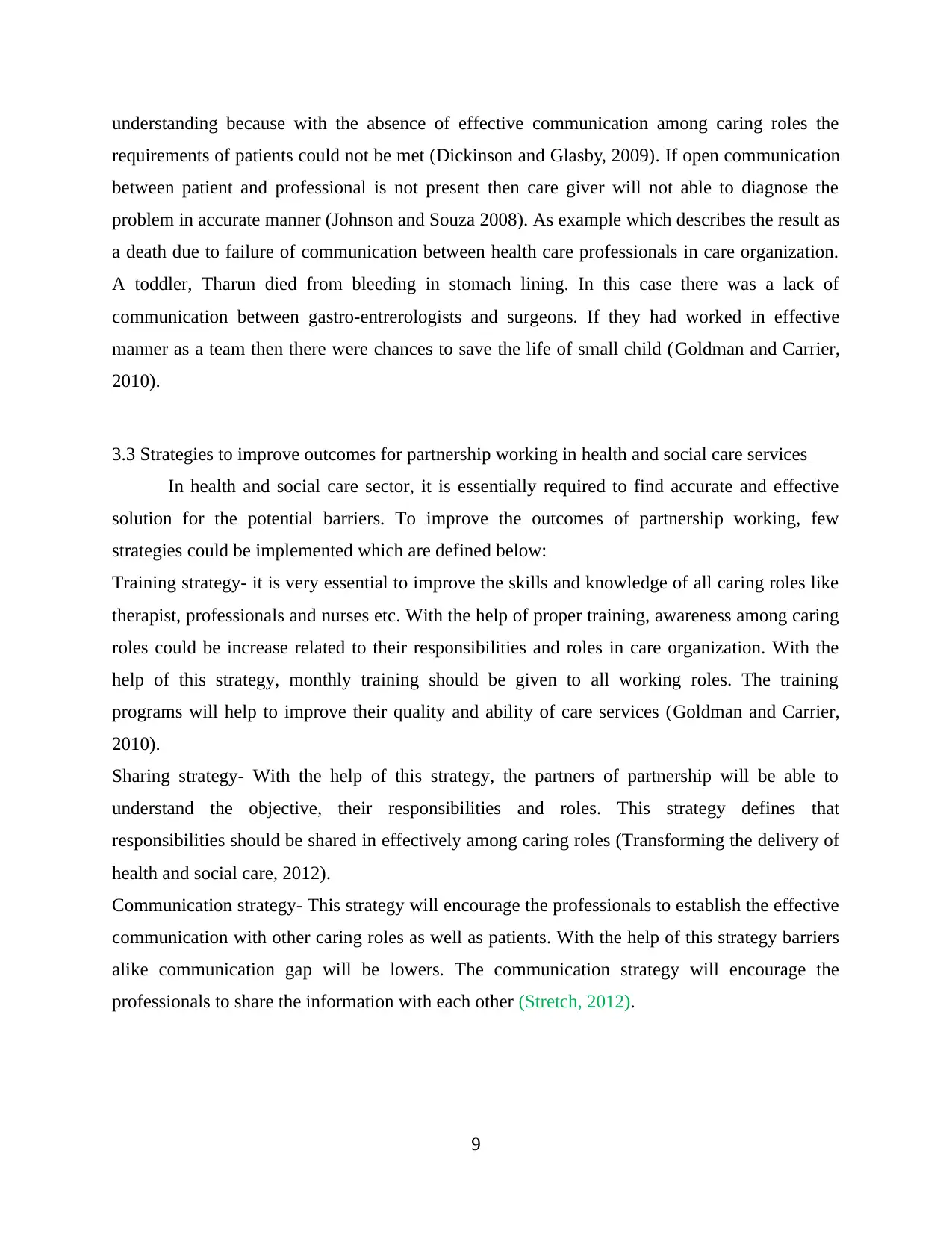
understanding because with the absence of effective communication among caring roles the
requirements of patients could not be met (Dickinson and Glasby, 2009). If open communication
between patient and professional is not present then care giver will not able to diagnose the
problem in accurate manner (Johnson and Souza 2008). As example which describes the result as
a death due to failure of communication between health care professionals in care organization.
A toddler, Tharun died from bleeding in stomach lining. In this case there was a lack of
communication between gastro-entrerologists and surgeons. If they had worked in effective
manner as a team then there were chances to save the life of small child (Goldman and Carrier,
2010).
3.3 Strategies to improve outcomes for partnership working in health and social care services
In health and social care sector, it is essentially required to find accurate and effective
solution for the potential barriers. To improve the outcomes of partnership working, few
strategies could be implemented which are defined below:
Training strategy- it is very essential to improve the skills and knowledge of all caring roles like
therapist, professionals and nurses etc. With the help of proper training, awareness among caring
roles could be increase related to their responsibilities and roles in care organization. With the
help of this strategy, monthly training should be given to all working roles. The training
programs will help to improve their quality and ability of care services (Goldman and Carrier,
2010).
Sharing strategy- With the help of this strategy, the partners of partnership will be able to
understand the objective, their responsibilities and roles. This strategy defines that
responsibilities should be shared in effectively among caring roles (Transforming the delivery of
health and social care, 2012).
Communication strategy- This strategy will encourage the professionals to establish the effective
communication with other caring roles as well as patients. With the help of this strategy barriers
alike communication gap will be lowers. The communication strategy will encourage the
professionals to share the information with each other (Stretch, 2012).
9
requirements of patients could not be met (Dickinson and Glasby, 2009). If open communication
between patient and professional is not present then care giver will not able to diagnose the
problem in accurate manner (Johnson and Souza 2008). As example which describes the result as
a death due to failure of communication between health care professionals in care organization.
A toddler, Tharun died from bleeding in stomach lining. In this case there was a lack of
communication between gastro-entrerologists and surgeons. If they had worked in effective
manner as a team then there were chances to save the life of small child (Goldman and Carrier,
2010).
3.3 Strategies to improve outcomes for partnership working in health and social care services
In health and social care sector, it is essentially required to find accurate and effective
solution for the potential barriers. To improve the outcomes of partnership working, few
strategies could be implemented which are defined below:
Training strategy- it is very essential to improve the skills and knowledge of all caring roles like
therapist, professionals and nurses etc. With the help of proper training, awareness among caring
roles could be increase related to their responsibilities and roles in care organization. With the
help of this strategy, monthly training should be given to all working roles. The training
programs will help to improve their quality and ability of care services (Goldman and Carrier,
2010).
Sharing strategy- With the help of this strategy, the partners of partnership will be able to
understand the objective, their responsibilities and roles. This strategy defines that
responsibilities should be shared in effectively among caring roles (Transforming the delivery of
health and social care, 2012).
Communication strategy- This strategy will encourage the professionals to establish the effective
communication with other caring roles as well as patients. With the help of this strategy barriers
alike communication gap will be lowers. The communication strategy will encourage the
professionals to share the information with each other (Stretch, 2012).
9
Paraphrase This Document
Need a fresh take? Get an instant paraphrase of this document with our AI Paraphraser
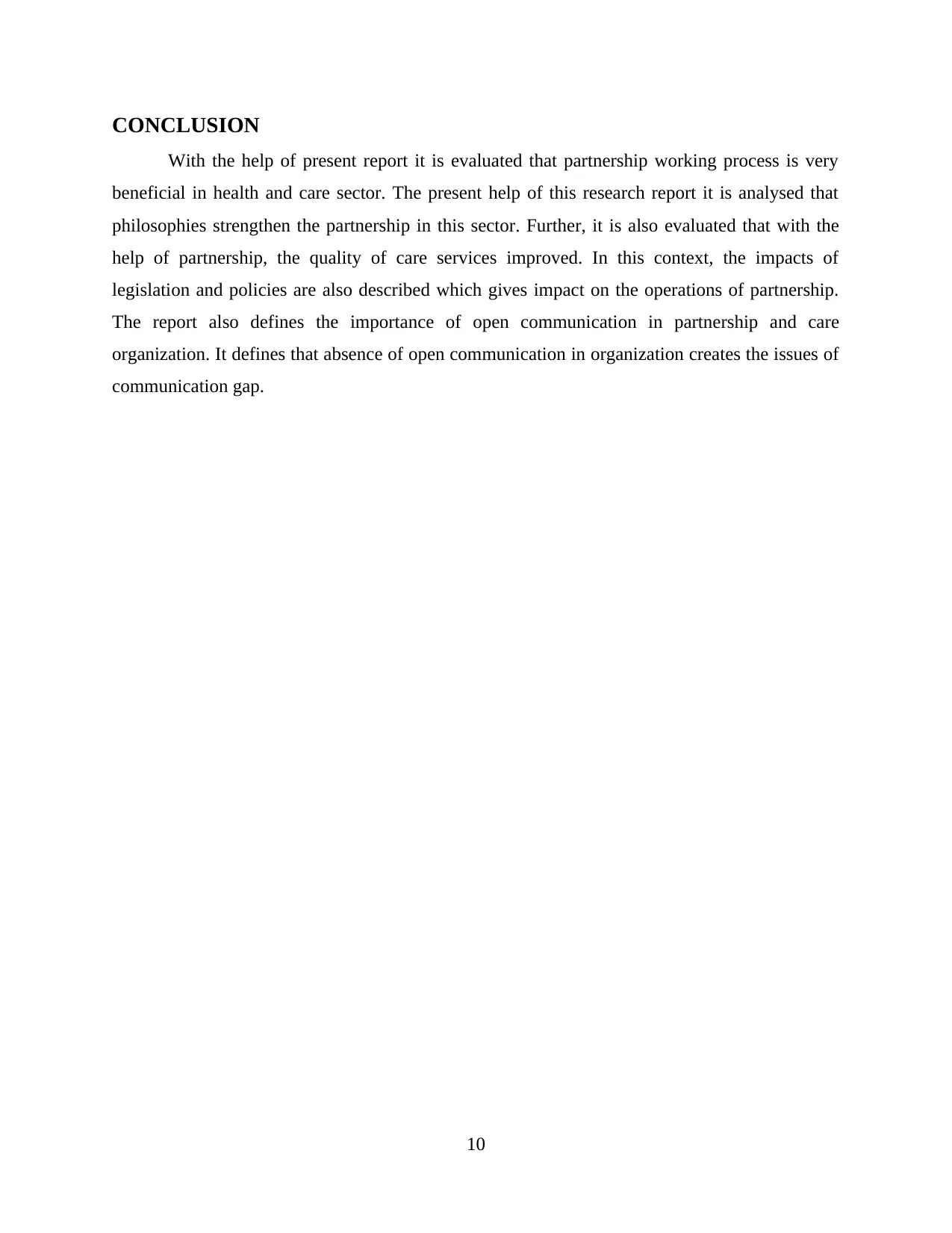
CONCLUSION
With the help of present report it is evaluated that partnership working process is very
beneficial in health and care sector. The present help of this research report it is analysed that
philosophies strengthen the partnership in this sector. Further, it is also evaluated that with the
help of partnership, the quality of care services improved. In this context, the impacts of
legislation and policies are also described which gives impact on the operations of partnership.
The report also defines the importance of open communication in partnership and care
organization. It defines that absence of open communication in organization creates the issues of
communication gap.
10
With the help of present report it is evaluated that partnership working process is very
beneficial in health and care sector. The present help of this research report it is analysed that
philosophies strengthen the partnership in this sector. Further, it is also evaluated that with the
help of partnership, the quality of care services improved. In this context, the impacts of
legislation and policies are also described which gives impact on the operations of partnership.
The report also defines the importance of open communication in partnership and care
organization. It defines that absence of open communication in organization creates the issues of
communication gap.
10

REFERENCES
Claire and et.al., 2011. Workplace Learning In Health And Social Care: A Student'S Guide: A
Student's Guide. McGraw Hill International.
Clarke, L., 2006. Health and Social Care. Nelson Thornes Limited.
Cook, R., 2006. Awareness and Influence in Health and Social Care: How You Can Really Make
a Difference. Radcliffe Publishing.
Cowan, D., 2009. Research Issues in Health and Social Care. M& K update Ltd.
Donnison, D., 2009. Speaking to Power: Advocacy for Health and Social Care. The policy
Press.
Fiona and et.al., 2006. Critical Reflection In Health And Social Care. McGraw Hill International.
Fisher, A., 2005. Health and Social Care. Heinemann.
Glasby, J., 2003. Hospital Discharge: Integrating Health and social care. Radcliffe.
R., , G. A., C. Evaluating Research in Health and Social care. Sage.
Haworth, E. and Foreshaw, C., 2002. GCSE Health and Social Care. Heinemann.
Johnson, J., and Souza C., 2008. Understanding Health and Social Care. SAGE Publications Ltd
Jones, M., 2009. Preparing for Professional Practice in Health and Social Care. John wiley and
Sons.
Blythe, J., 2010. Trade fairs as communication: a new model. Journal of Business & Industrial
Marketing. 25(1). pp.57–62
Dickinson, H. and Glasby, J., 2009. International Perspectives on Health and Social Care:
Partnership Working in Action. John Wiley & Sons.
Martin, V., 2012. Managing Projects in Health and Social Care. Routledge.
May, A., 2009. Communities of Practice in Health and Social Care. John wiley and Sons.
Goldman, C. and Carrier, J., 2010. Joint Financing in the New NHS: Thinking to the Future.
Journal of Integrated Care. 18(6).pp.27 – 34.
Stretch, B., 2012. Health and Social Care.London: Heinemann.
11
Claire and et.al., 2011. Workplace Learning In Health And Social Care: A Student'S Guide: A
Student's Guide. McGraw Hill International.
Clarke, L., 2006. Health and Social Care. Nelson Thornes Limited.
Cook, R., 2006. Awareness and Influence in Health and Social Care: How You Can Really Make
a Difference. Radcliffe Publishing.
Cowan, D., 2009. Research Issues in Health and Social Care. M& K update Ltd.
Donnison, D., 2009. Speaking to Power: Advocacy for Health and Social Care. The policy
Press.
Fiona and et.al., 2006. Critical Reflection In Health And Social Care. McGraw Hill International.
Fisher, A., 2005. Health and Social Care. Heinemann.
Glasby, J., 2003. Hospital Discharge: Integrating Health and social care. Radcliffe.
R., , G. A., C. Evaluating Research in Health and Social care. Sage.
Haworth, E. and Foreshaw, C., 2002. GCSE Health and Social Care. Heinemann.
Johnson, J., and Souza C., 2008. Understanding Health and Social Care. SAGE Publications Ltd
Jones, M., 2009. Preparing for Professional Practice in Health and Social Care. John wiley and
Sons.
Blythe, J., 2010. Trade fairs as communication: a new model. Journal of Business & Industrial
Marketing. 25(1). pp.57–62
Dickinson, H. and Glasby, J., 2009. International Perspectives on Health and Social Care:
Partnership Working in Action. John Wiley & Sons.
Martin, V., 2012. Managing Projects in Health and Social Care. Routledge.
May, A., 2009. Communities of Practice in Health and Social Care. John wiley and Sons.
Goldman, C. and Carrier, J., 2010. Joint Financing in the New NHS: Thinking to the Future.
Journal of Integrated Care. 18(6).pp.27 – 34.
Stretch, B., 2012. Health and Social Care.London: Heinemann.
11
⊘ This is a preview!⊘
Do you want full access?
Subscribe today to unlock all pages.

Trusted by 1+ million students worldwide
1 out of 13
Related Documents
Your All-in-One AI-Powered Toolkit for Academic Success.
+13062052269
info@desklib.com
Available 24*7 on WhatsApp / Email
![[object Object]](/_next/static/media/star-bottom.7253800d.svg)
Unlock your academic potential
Copyright © 2020–2025 A2Z Services. All Rights Reserved. Developed and managed by ZUCOL.





